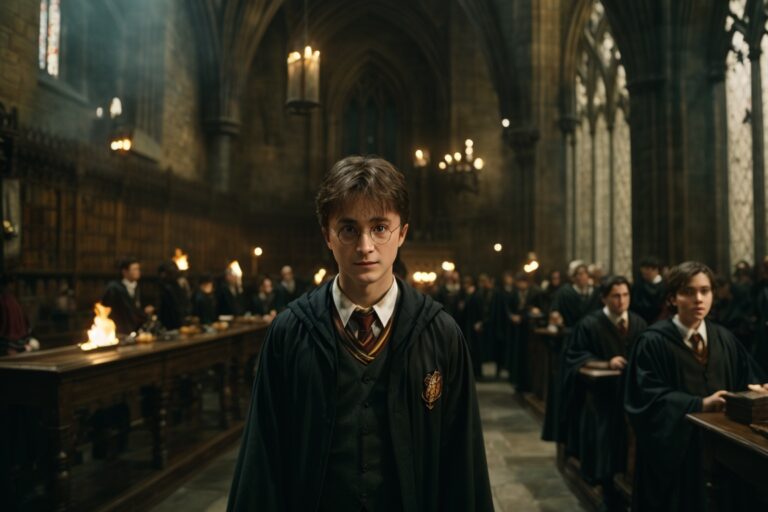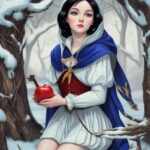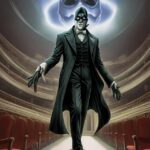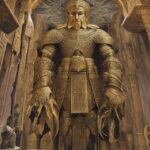Discover the enthralling world of wizardry and adventure as we delve into the critically acclaimed fifth installment of the beloved Harry Potter series: “Harry Potter and the Order of the Phoenix.” Authored by the remarkable J.K. Rowling, this captivating book takes us on a spellbinding journey through Harry’s tumultuous fifth year at Hogwarts School of Witchcraft and Wizardry.
Drawing upon historic data and Rowling’s masterful storytelling prowess, we unlock the secrets that make this installment a timeless classic, inspiring generations of readers worldwide. Join us as we explore the key themes, unravel significant plot twists, and uncover the jaw-dropping revelations that await within the pages of this phenomenal novel.
Intrigue builds as we aim to satisfy your search intention by providing a comprehensive yet concise summary, ensuring that you embark on this literary adventure with a deeper understanding and appreciation for “Harry Potter and the Order of the Phoenix.” Don’t miss the opportunity to immerse yourself in a narrative that has captured the hearts and imaginations of millions of readers. Keep reading as we traverse the enchanting realms that lie ahead.
Harry Potter and the Order of the Phoenix: Full Book Summary
Once upon a time, in a world filled with witches, wizards, and magical creatures, there lived a boy named Harry Potter. Harry had spent the previous summer at the Dursleys’, his mean and unpleasant relatives, eagerly awaiting his return to Hogwarts School of Witchcraft and Wizardry.
But when Harry does arrive at Hogwarts, everything feels different. People are whispering and staring at him as if he’s done something wrong. Even his best friends, Ron and Hermione, seem to be avoiding him. Little did he know that the wizarding world had been turned upside down since the return of Lord Voldemort, the dark and evil wizard who had tried to kill Harry as a baby.
At Hogwarts, Harry learns about the Order of the Phoenix, a secret society formed by his beloved parents and their friends to fight against Voldemort. Led by the wise and powerful Albus Dumbledore, the Order is determined to stop Voldemort from rising to power again. Harry soon becomes a member of this brave group, joining his godfather Sirius Black, Remus Lupin, and other familiar faces who fought alongside his parents during the first Wizarding War.
As the school year progresses, Harry finds himself facing immense challenges. The new Defense Against the Dark Arts teacher, Dolores Umbridge, is incredibly strict and cruel. She refuses to teach students practical defensive magic, insisting that theory is sufficient. Harry, along with his friends, forms “Dumbledore’s Army” secretly to receive practical training themselves. Together, they learn spells and battle techniques, preparing themselves for what lies ahead.
But Harry is also plagued by disturbing dreams. He senses Voldemort’s strong emotions and occasionally sees through his eyes. The connection between Harry and Voldemort begins to grow stronger, and eventually, Harry discovers that the dark wizard is looking for something important at the Ministry of Magic.
Desperate to stop Voldemort, Harry and his friends secretly break into the Ministry. There, they encounter Death Eaters, Voldemort’s loyal followers, and engage in a fierce battle. Harry’s friends fight valiantly, trying to protect one another. Meanwhile, Harry faces off against Voldemort himself. In a moment of intense struggle, Harry learns a shocking truth about a prophecy made years ago, which reveals that only one of them can survive.
Ultimately, Harry escapes with his friends and members of the Order, but the battle leaves a lasting impact on the wizarding world. The ministry finally acknowledges Voldemort’s return and launches a full-scale effort to fight against him. Harry, with the support of his friends and the Order, knows he must face whatever challenges lie ahead in order to save not only himself but everyone he cares about.
Throughout his journey, Harry learns the importance of friendship, loyalty, and bravery. He discovers his own strength and realizes that even in the darkest times, he is never alone. With love, courage, and unwavering determination, Harry Potter stands against the forces of evil, inspiring readers of all ages to believe in the power of good triumphing over darkness.
In “Harry Potter and the Order of the Phoenix,” author J.K. Rowling takes readers on a thrilling adventure filled with magical creatures, intense battles, and emotional growth. This fifth installment in the beloved Harry Potter series continues to captivate both children and adults alike, teaching valuable lessons about resilience, compassion, and the importance of standing up for what is right. Harry’s journey reminds us that no matter how difficult life may become, there is always hope, and that the power of love and friendship can conquer even the darkest of circumstances. So, grab your broomstick, put on your invisibility cloak, and immerse yourself in the enchanting world of Harry Potter!
Harry Potter and the Order of the Phoenix: Key Themes
The book “Harry Potter and the Order of the Phoenix” by J.K. Rowling is a thrilling and magical tale that introduces several central themes:
1. Rebellion against Authority: One key theme in this book is the rebellion against authority. Harry Potter and his friends confront Dolores Umbridge, who is appointed as the Defense Against the Dark Arts teacher at Hogwarts but abuses her power by suppressing information about dark forces. Harry, feeling frustrated by the lack of support from the Ministry of Magic and his school, forms a secret resistance group called Dumbledore’s Army. This theme highlights the importance of questioning authority and fighting against injustice, even if it means going against those in power.
2. Loss and Grief: Another prominent theme in this book is loss and grief. Harry experiences the loss of his godfather, Sirius Black, which has a profound impact on him. Throughout the story, Harry struggles with his grief, feeling guilt, sadness, and anger. It explores how different characters deal with loss and teaches valuable lessons about the grieving process, highlighting the importance of love and support to heal emotionally.
3. The Power of Friendship: Friendship plays a significant role in this book, emphasizing the power of unity and loyalty. Despite the challenges they face, Harry’s friends Ron and Hermione, along with other students, stand by his side. Friendship becomes a source of strength for Harry, who relies on the support and understanding of his friends to navigate through difficult times. This theme demonstrates the importance of friendship in overcoming adversity and promotes the values of trust, loyalty, and companionship.
In summary, “Harry Potter and the Order of the Phoenix” explores themes of rebellion against authority, loss and grief, and the power of friendship. These themes add depth and complexity to the story, creating a compelling narrative that resonates with readers.
Harry Potter and the Order of the Phoenix: Characters
Harry Potter
The central protagonist of the series, Harry is a brave and determined wizard with unruly black hair and glasses. In “Harry Potter and the Order of the Phoenix,” he finds himself feeling isolated as he grapples with the aftermath of Cedric’s death and confronts the wizarding world’s disbelief in Voldemort’s return. Despite the immense pressure, Harry demonstrates remarkable resourcefulness and leadership skills, forming Dumbledore’s Army to teach his fellow students defensive magic against the wishes of the Ministry of Magic. Funny data: Harry has a knack for finding himself in dangerous situations, often by accident.
Hermione Granger
Harry’s best friend, Hermione is a brilliant witch with bushy brown hair and a tendency to be a bit of a know-it-all. In this book, Hermione becomes a key member of Dumbledore’s Army and uses her intellect to help Harry uncover the truth about Voldemort’s return. She also continues to champion the rights of house-elves, much to the annoyance of her skeptical friends. Funny data: Hermione’s extensive knowledge and impeccable memory come in handy, but can also lead to humorous situations where she corrects her friends’ mistakes.
Ron Weasley
Harry’s other best friend, Ron is a tall, red-headed wizard with a penchant for making amusing comments. In “Order of the Phoenix,” Ron faces personal challenges as his insecurities are exacerbated by his older brothers’ achievements. Despite these struggles, Ron remains fiercely loyal to Harry and stands by him throughout the book, joining Dumbledore’s Army and taking part in their rebellious activities. Funny data: Ron has a profound fear of spiders, resulting in comedic situations when he is forced to confront them.
Albus Dumbledore
The wise and enigmatic headmaster of Hogwarts School of Witchcraft and Wizardry, Dumbledore is known for his long white beard, half-moon glasses, and twinkling blue eyes. In this book, Dumbledore is under scrutiny from the Ministry of Magic, and his interactions with Harry become limited. However, he remains a guiding force for Harry, providing him with crucial information and support when he can. Funny data: Dumbledore has an affinity for quirky and unconventional objects that often confuse those around him.
Sirius Black
Harry’s godfather and a former inmate of Azkaban, Sirius is described as tall and thin, with long, matted black hair and a rugged appearance. In “Order of the Phoenix,” Sirius plays a more prominent role as he forms a crucial part of the Order of the Phoenix, a secret society created to fight against Voldemort. He serves as a father figure to Harry, providing emotional support and guidance. Funny data: Sirius is a bit of a risk-taker, often disregarding rules and enjoying a mischievous sense of humor.
Dolores Umbridge
The book’s main antagonist, Umbridge is a squat, pink-faced woman with short, curly hair and an affinity for wearing pastel-colored suits. As the new Defense Against the Dark Arts professor, Umbridge’s strict and oppressive teaching methods clash with Harry’s desire to learn practical defense magic. She serves as a representative of the Ministry of Magic, spreading propaganda and suppressing any mention of Voldemort’s return. Funny data: Despite her unpleasant nature, Umbridge has a strange fondness for decorative plates with cartoon kittens.
Harry Potter and the Order of the Phoenix: Symbols
1. Phoenix: The phoenix is a powerful symbol throughout the book and represents both destruction and rebirth. It is seen as an emblem of hope and resilience, just like the Order of the Phoenix itself, a secret society formed to fight against Lord Voldemort. The phoenix is particularly embodied in the character of Fawkes, Albus Dumbledore’s loyal pet, who provides support and aid to Harry in his battles against evil. The presence of the phoenix signifies that even in the darkest times, there is always a chance for renewal and redemption.
2. Thestrals: Thestrals are mystical creatures that can only be seen by those who have witnessed and comprehended death. They are described as skeletal, winged horses with dragon-like heads. In the book, thestrals serve as a symbol of the hidden scars and trauma carried by individuals who have experienced loss. Harry, who can now see thestrals due to witnessing Cedric Diggory’s death in the previous installment, connects with Neville Longbottom, who also sees them. Their shared ability to see thestrals represents their shared understanding of grief and allows them to bond over their trauma.
3. Prophecy Orb: The prophecy orb is a crystal ball containing a prophecy about the destruction of Lord Voldemort. It symbolizes the power of foresight and the weight of destiny. The prophecy is central to the plot, as it drives the actions of both Voldemort and Harry. It represents the consequential nature of choice and how one’s decisions can shape the future. The prophecy orb serves to highlight the theme of fate versus free will, as characters grapple with whether to accept their predetermined paths or forge their own destinies.
Harry Potter and the Order of the Phoenix: Culture Impact
Harry Potter and the Order of the Phoenix, the fifth installment in the renowned Harry Potter book series by J.K. Rowling, made a profound impact on popular culture. Published in 2003, the book mesmerized audiences around the globe, and its cultural influence still reverberates today.
Historically, the release of Harry Potter and the Order of the Phoenix marked a pivotal moment in literary history. The anticipation leading up to its publication was unprecedented, with fans queuing for hours outside bookstores to be among the first to get their hands on a copy. This frenzy surrounding the book’s release highlighted the unwavering dedication and enthusiasm of Harry Potter fans, creating a sense of community and collective excitement on an international scale.
What sets this book apart from its predecessors is its darker and more mature tone. Rowling tackled themes such as loss, betrayal, and the dangers of authoritarian regimes. As the protagonist navigates the challenges of adolescence while facing an oppressive government within the wizarding world, readers were able to relate to the story’s underlying journey of personal growth and struggle. The book’s exploration of complex emotions struck a chord with readers of all ages, resulting in a more diverse and widespread fan base.
Despite its heavy themes, Harry Potter and the Order of the Phoenix also expertly interweaves moments of humor, providing readers with much-needed relief from the mounting tension. Rowling’s skill in balancing wit and gravity ensured that readers remained engaged and emotionally connected throughout the narrative. The book’s ability to seamlessly transition between heart-wrenching scenes and light-hearted humor contributed to its widespread appeal.
Furthermore, Harry Potter and the Order of the Phoenix showcased Rowling’s genius in crafting an intricate and immersive fictional world. The introduction of the Order of the Phoenix, a secret society formed to fight the dark forces of Lord Voldemort, expanded the magical universe in exciting new ways. The book deepened our understanding of the underlying mythology, introducing captivating new characters and detailing the history of the wizarding world. Rowling’s meticulous attention to detail drew readers further into the story, fueling their imaginations and sparking a newfound fascination with the intricacies of the wizarding realm.
Achievement-wise, Harry Potter and the Order of the Phoenix cemented Rowling’s status as a literary powerhouse. It shattered numerous records, becoming the fastest-selling book in history at the time. Its commercial success further propelled the Harry Potter franchise into a global phenomenon, leading to the creation of blockbuster movies, merchandise, theme parks, and a dedicated fan base that persists to this day.
Culturally, this book revolutionized the perception of children’s literature. Its immense popularity and widespread acclaim shattered the notion that books for young readers were irrelevant or lacked depth. Harry Potter and the Order of the Phoenix sparked a renewed appreciation for the power of storytelling, inspiring a wave of young readers to dive into the magical world of literature.
In conclusion, Harry Potter and the Order of the Phoenix exerted a significant cultural impact. From its unprecedented anticipation to its ability to captivate readers with its blend of humor, darkness, and emotional depth, the book transcended the literary realm to become a cultural phenomenon. Its historic achievements and enduring popularity solidified its place as a timeless classic that continues to enthrall audiences, allowing the magic of Harry Potter to live on.
FAQs
1. What is the main plot of “Harry Potter and the Order of the Phoenix”?
In “Harry Potter and the Order of the Phoenix,” Harry returns to Hogwarts for his fifth year and faces various challenges. He learns of a secret society called the Order of the Phoenix, which is dedicated to fighting Lord Voldemort and his followers. As Harry struggles with the Ministry of Magic’s denial of Voldemort’s return, he also confronts personal and emotional battles while forming a rebellious group called Dumbledore’s Army.
2. Does Harry face any new magical creatures in this book?
While “Harry Potter and the Order of the Phoenix” focuses more on the political and emotional aspects of the wizarding world, there are a few encounters with new creatures. For example, Harry encounters thestrals, which are skeletal, winged horses that can only be seen by those who have witnessed death. Additionally, there are brief encounters with centaurs and gargoyles.
3. Why is Dolores Umbridge such a memorable character?
Dolores Umbridge is a major antagonist in “Harry Potter and the Order of the Phoenix.” She is known for her strict and tyrannical rule over Hogwarts as the Defense Against the Dark Arts teacher and later as the High Inquisitor of Hogwarts. Her pink color scheme, obsession with rules and regulations, and cruel punishment methods make her one of the most despised characters in the series.
4. What role does the prophecy play in this book?
The prophecy is a significant story element in “Harry Potter and the Order of the Phoenix.” It is revealed that a prophecy was made regarding Harry and Voldemort, stating that one cannot live while the other survives. The prophecy’s exact content remains a mystery until later in the series, but it becomes a driving force for Voldemort’s desire to kill Harry and Harry’s determination to stop him.
5. How does Harry’s relationship with his friends change in this book?
“Harry Potter and the Order of the Phoenix” depicts a strain in Harry’s relationships with his friends, primarily Ron and Hermione. Due to his trauma and isolation from the events of the previous book, Harry becomes more withdrawn and feels misunderstood. This causes tension and arguments with his friends, but eventually, they reconcile and support him as he battles against Voldemort and the challenges ahead.
6. Who are the members of the Order of the Phoenix and what is their purpose?
The Order of the Phoenix is a secret society of witches and wizards who oppose Lord Voldemort and his Death Eaters. It was founded by Albus Dumbledore during the first wizarding war, and reactivated when Voldemort returned. Some of its members are: Harry Potter, Ron Weasley, Hermione Granger, Sirius Black, Remus Lupin, Alastor Moody, Kingsley Shacklebolt, Nymphadora Tonks, Arthur Weasley, Molly Weasley, Fred Weasley, George Weasley, Bill Weasley, Charlie Weasley, Ginny Weasley, Neville Longbottom, Luna Lovegood, Minerva McGonagall, Severus Snape, and Hagrid.
7. What is the prophecy that Harry and Dumbledore heard in the Department of Mysteries?
The prophecy was made by Sybill Trelawney, the divination teacher at Hogwarts, and it predicted the birth of a boy who would have the power to vanquish Voldemort. The prophecy said: “The one with the power to vanquish the Dark Lord approaches… born to those who have thrice defied him, born as the seventh month dies… and the Dark Lord will mark him as his equal, but he will have power the Dark Lord knows not… and either must die at the hand of the other for neither can live while the other survives… the one with the power to vanquish the Dark Lord will be born as the seventh month dies…”. The prophecy could have referred to either Harry Potter or Neville Longbottom, but Voldemort chose to attack Harry, thus marking him as his equal and making the prophecy about him.
8. How did Dumbledore die and who killed him?
Dumbledore died on the Astronomy Tower of Hogwarts, where he was confronted by a group of Death Eaters, who are followers of Voldemort. He was killed by Severus Snape, who was acting on Dumbledore’s own request. Dumbledore had asked Snape to kill him if the situation arose, because he was already dying from a curse he received when he tried to destroy one of Voldemort’s Horcruxes, the ring. Dumbledore also wanted to protect Draco Malfoy, who was ordered by Voldemort to kill Dumbledore, but hesitated to do so. Snape agreed to kill Dumbledore to maintain his cover as a double agent and to prevent anyone else from killing him.
9. What is the role of the Ministry of Magic and how does it affect Harry and his friends?
The Ministry of Magic is the governing body of the wizarding world in Britain. It is composed of various departments and officials, such as the Minister for Magic, the Aurors, and the Wizengamot. The Ministry of Magic plays a major role in Harry Potter and the Order of the Phoenix, as it denies the return of Voldemort and tries to discredit Harry and Dumbledore. The Ministry also interferes with Hogwarts by appointing Dolores Umbridge as the Defence Against the Dark Arts teacher and later as the High Inquisitor. Umbridge imposes strict rules and punishments on the students and teachers, and tries to stop Harry from learning and teaching defensive magic. Harry and his friends form a secret group called Dumbledore’s Army to resist Umbridge and the Ministry.
10. What is the significance of the locket that Harry and Dumbledore found in the cave?
The locket that Harry and Dumbledore found in the cave was supposed to be one of Voldemort’s Horcruxes, an object that contains a fragment of his soul and makes him immortal. However, when they opened the locket, they discovered that it was a fake, and that someone had taken the real one and left a note saying “R.A.B.”. The locket was actually a family heirloom of the Black family, and it was stolen by Regulus Black, Sirius Black’s brother, who was a former Death Eater. Regulus had learned about Voldemort’s Horcruxes and decided to betray him and destroy the locket. He took the locket from the cave and replaced it with the fake one, but he died in the process. The locket was later taken by Kreacher, the Black family’s house-elf, who hid it in the house of 12 Grimmauld Place.










